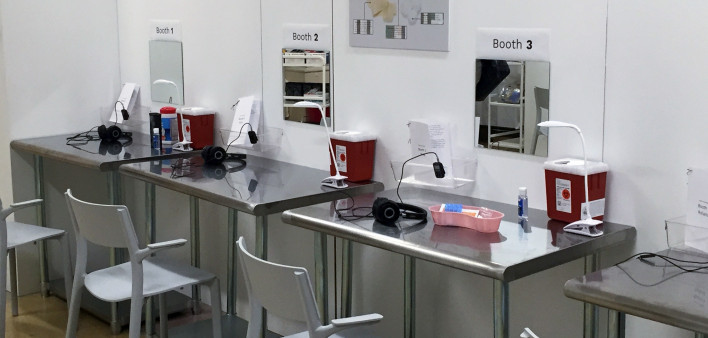
By: Mike Stehlin, Staff Editor
Some called it El Campamento.[I] Used syringes were discarded, stacked on top of each other, and strewn about on the ground, a metaphor of the dead bodies that the drugs left in their wake. The “residents” of the encampment typically included 75 to 125 drug addicts at any one time.[ii] If one was looking for an image to capture the severity with which the opioid epidemic has gripped a neighborhood, a city, a nation, it was found in that Philadelphia drug encampment.
That particular settlement was razed by bulldozers in 2017.[iii] However, the long-term solution to the drug crisis in this country figures to be far more elusive. Mayor Jim Kenney and other community leaders in Philadelphia, a city that experienced more than 2,300 accidental overdose deaths in 2017 and 2018 combined[iv], are proposing an unconventional method.
In 2017 a task force created by the Mayor proposed allowing safe injection sites within the city.[v] The sites would provide facilities where citizens could inject heroin under the supervision of medical professionals.[vi]
The proposition immediately raises two questions:
- Would such a site be legal?
- Even if it were legal, should the city allow such sites?
Last month, a federal district judge in Philadelphia answered the former. The United States brought a declaratory judgment action against Safehouse, a nonprofit dedicated to overdose prevention in Philadelphia[vii], and its president.[viii] The government sought to enjoin the organization from opening a safe injection site in Philadelphia. [ix]
The Proposed Site
Safehouse proposed opening an “Overdose Prevention Site.”[x] The proposed facility would contain medically supervised consumption rooms, where staff provide drug users with sterile materials to inject the drugs.[xi] The facility staff would have no involvement in the procurement, handling, or injection of the controlled substances. [xii] Rather, the staff would supervise in order to render medical care when necessary, including the administration of overdose reversing agents.[xiii]
After consuming drugs using the sterile materials, participants have the option to wait in a medically supervised observation room.[xiv] In addition to the medical personnel, recovery specialists, social workers, and case managers would be onsite to encourage drug users to seek treatment as well as provide services.[xv]
The Government’s Contention
The Government argued that the consumption room, as described by Safehouse, violated 21 U.S.C. § 856(a)(2).[xvii]
The statute makes it a crime to: [M]anage or control any place, whether permanently or temporarily, either as an owner, lessee, agent, employee, occupant, or mortgagee, and knowingly and intentionally rent, lease, profit from, or make available for use, with or without compensation, the place for the purpose of unlawfully manufacturing, storing, distributing, or using a controlled substance.[xviii]
The Opinion
In a memorandum opinion, Judge Gerald ruled in favor of Safehouse.[xix] The opinion was rich with analysis of the statutory construction of the section at issue.[xx] The phrase – “for the purpose of unlawfully . . . using a controlled substance” – was especially critical to the court.[xxi] Regarding the scope, the court determined that one of the statutorily proscribed purposes must be a significant or primary purpose of the place.[xxii] Safehouse’s goals of reducing the harm caused by drug use, rendering medical care, encouraging treatment, and assisting with social services are not such purposes. Ultimately, the court ruled that allowing some drug use as part of a larger effort to combat drug use did not violate the statue.[xxiii]
The Aftermath
This legal issue is worth tracking. U.S. Attorney William McSwain has indicated that the Justice Department will appeal the decision, and he will use any legal mechanism he can to prevent a safe injection site from opening before the Third Circuit weighs in.[xxiv] At least for now, there is a little more clarity in the legal landscape.
The issue now moves to the court of public opinion. That court will be tasked with answering some difficult questions: can we afford to have these sanctioned drug facilities in our communities? Can we afford not to? Only time will tell what the decision will be and how that precedent will be judged.
[i]Stephanie Farr & Sam Wood, A Hidden Hellscape, Phila. Inquirer (Feb. 19, 2017), https://www.inquirer.com/health/opioid-addiction/inq/hidden-hellscape-20170219.html.
[ii]Id.
[iii]Joel Wolfram, Cleanup Work Along Philly Conrail Tracks Reaches ‘El Campamento’ Heroin Haven, WHYY (Aug. 10, 2017), https://whyy.org/articles/cleanup-work-along-philly-conrail-tracks-reaches-notorious-heroin-haven-el-campamento/.
[iv]Aubrey Whelan & Juliana Feliciano Reyes, Philadelphia’s Overdose Deaths Dip Overall in 2018 but are ‘Still at Crisis Levels’, Phila. Inquirer (Updated May 14, 2019),https://www.inquirer.com/health/opioid-overdose-deaths-philadelphia-20190514.html.
[v]Don Sapatkin, Safe Injection Sites Worth Considering, Says Philly Mayor’s Opioid Task Force, Phila. Inquirer(May 19, 2017), https://www.inquirer.com/philly/health/addiction/safe-injection-sites-philly-mayors-opioid-task-force-heroin-conrail-kensington-20170519.html.
[vi]Id.
[vii]Safehouse, https://www.safehousephilly.org/(last visited Nov. 9, 2019).
[viii]United States v. Safehouse, No. 19-0519, 2019 U.S. Dist. LEXIS 170912, at 10 (E.D. PA. Oct. 2, 2019).
[ix]Id.at 10.
[x]Id.at 12.
[xi]Id.at 13.
[xii]Id.at 13.
[xiii]Id.at 13.
[xiv]Id.at 13.
[xv]Id.at 13-14.
[xvi]Id.at 14.
[xvii]21 U.S.C. § 856(a)(2) (2012).
[xviii]Safehouseat 10, 85.
[xix]Seeid., passim.
[xx]Id.at 54-55.
[xxi]Id.at 56, 61.
[xxii]Id.at 85.
[xxiii]Jeremy Roebuck & Aubrey Whelan, U.S. Attorney Threatens to Close Philly SupervisedInjectionSite if it OpensBefore Appeals Courts Weigh in, Phila. Inquirer(lastupdatedOct. 15, 2019).